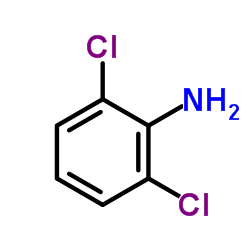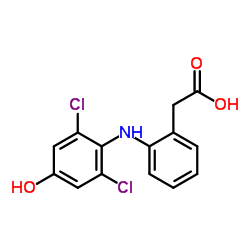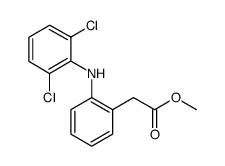15307-86-5
| 中文名 | 双氯芬酸 |
|---|---|
| 英文名 | diclofenac |
| 中文别名 | 2-(2,6-二氯苯氨基)苯乙酸 |
| 英文别名 |
2-{2-[(2,6-dichlorophenyl)amino]phenyl}acetic acid
Benzeneacetic acid, 2-((2,6-dichlorophenyl)amino)- 2-(2-((2,6-dichlorophenyl)amino)phenyl)acetic acid Acetic acid, (o-(2,6-dichloroanilino)phenyl)- 2-[[2,6-Dichlorophenyl]amino]benzeneacetic acid MFCD00451393 2-((2,6-dichlorophenyl)amino)benzeneacetic acid Diclofenac acid 2-[2-[(2,6-dichlorophenyl)amino]phenyl]acetic acid N-(2,6-Dichlorophenyl)-o-aminophenylacetic Acid Zorvolex EINECS 239-348-5 {2-[(2,6-Dichlorophenyl)amino]phenyl}acetic acid [2-(2,6-dichloroanilino)phenyl]acetic acid Benzeneacetic acid, 2-[(2,6-dichlorophenyl)amino]- Motifene (o-(2,6-Dichloroanilino)phenyl)acetic Acid |
| 描述 | Diclofenac 是一种有效的,非选择性的抗炎剂,为 COX 的抑制剂,在 CHO 细胞中,对人 COX-1 和 COX-2 的 IC50 值分别为 4 nM,1.3 nM;Diclofenac 同时对绵羊 COX-1 和 COX-2 的 IC50 值分别为 5.1 μM,0.84 μM。 |
|---|---|
| 相关类别 | |
| 靶点 |
Human COX-2:1.3 nM (IC50, in CHO cells) Human COX-1:4 nM (IC50, in CHO cells) Ovine COX-2:0.84 μM (IC50) Ovine COX-1:5.1 μM (IC50) |
| 体外研究 | 双氯芬酸是一种有效的COX抑制剂,CHO细胞中人COX-1和COX-2的IC50分别为4 nM和1.3 nM。双氯芬酸有效阻断UX37细胞微粒体中COX-1介导的前列腺素产生,IC50为7±3 nM [1]。双氯芬酸钠表现出对COX-1和COX-2酶的抑制作用,IC50分别为5.1和0.84μM[2]。 |
| 体内研究 | 双氯芬酸(3mg/kg,bid,5天)显着增加大鼠粪便51Cr排泄,并且在施用1mg/kg每天两次,持续4天后,在松鼠猴中也观察到这种效果[1]。双氯芬酸(10mg/kg)在小鼠中显示出抗炎活性[2]。双氯芬酸(10 mg/kg)可降低氧化低密度脂蛋白(Ox-LDL),但通过肌内注射大鼠对过氧化氢酶和谷胱甘肽过氧化物酶的动力学参数没有影响[3]。 |
| 动物实验 | 大鼠[1]雄性Sprague-Dawley大鼠(150±200g)口服给予双氯芬酸一次(急性给药)或每天两次,持续5天(慢性给药)。在第4天早晨剂量后1小时获得血浆样品,用于测量双氯芬酸浓度。在第5天给予最后一次剂量后,立即通过尾静脉向大鼠注射来自供体大鼠的0.5mL 51Cr标记的红细胞,其与51铬酸钠一起孵育。将大鼠单独置于代谢笼中,随意食物和水。收集粪便48小时,51Cr粪便排泄量计算为总注射剂量的百分比(每只动物20mCi)[1]。松鼠猴[1]松鼠猴(Saimiri sciureus; 0.8±1.4 kg)口服双氯芬酸,每日两次,持续1±5天。给予最后一剂后1小时,通过隐静脉注射51CrCl3的无菌盐水(1mL / kg,每只动物4±5mCi),并获得血浆样品用于测量双氯芬酸浓度。然后将猴子单独圈养在代谢笼中。收集粪便24小时,51Cr粪便排泄量计算为总注射剂量的百分比[1]。 |
| 参考文献 |
| 密度 | 1.4±0.1 g/cm3 |
|---|---|
| 沸点 | 412.0±45.0 °C at 760 mmHg |
| 熔点 | 156-158ºC |
| 分子式 | C14H11Cl2NO2 |
| 分子量 | 296.149 |
| 闪点 | 203.0±28.7 °C |
| 精确质量 | 295.016693 |
| PSA | 49.33000 |
| LogP | 4.06 |
| 外观性状 | 白色至淡黄色结晶粉末 |
| 蒸汽压 | 0.0±1.0 mmHg at 25°C |
| 折射率 | 1.662 |
| 储存条件 | 室温,干燥 |
| 水溶解性 | 可溶于:甲醇 |
|
2-(2,6-Dichloroanilino)phenylacetic Acid
Revision number: 5
SAFETY DATA SHEET Section1. IDENTIFICATION Product name:2-(2,6-Dichloroanilino)phenylacetic Acid Revision number:5 Section2. HAZARDS IDENTIFICATION GHS classification PHYSICAL HAZARDSNot classified HEALTH HAZARDS Acute toxicity (Oral)Category 3 Not classified ENVIRONMENTAL HAZARDS GHS label elements, including precautionary statements Pictograms or hazard symbols Signal wordDanger Hazard statementsToxic if swallowed Precautionary statements: [Prevention]Do not eat, drink or smoke when using this product. Wash hands thoroughly after handling. IF SWALLOWED: Immediately call a POISON CENTER or doctor/physician. Rinse [Response] mouth. Store locked up. [Storage] [Disposal]Dispose of contents/container through a waste management company authorized by the local government. Section3. COMPOSITION/INFORMATION ON INGREDIENTS Substance/mixture:Substance Components:2-(2,6-Dichloroanilino)phenylacetic Acid Percent:>98.0%(GC)(T) CAS Number:15307-86-5 Synonyms:Diclofenac Chemical Formula:C14H11Cl2NO2 Section4. FIRST AID MEASURES Inhalation:Remove victim to fresh air and keep at rest in a position comfortable for breathing. Get medical advice/attention if you feel unwell. Skin contact:Remove/Take off immediately all contaminated clothing. Rinse skin with water/shower. If skin irritation or rash occurs: Get medical advice/attention. 2-(2,6-Dichloroanilino)phenylacetic Acid Section4. FIRST AID MEASURES Eye contact:Rinse cautiously with water for several minutes. Remove contact lenses, if present and easy to do. Continue rinsing. If eye irritation persists: Get medical advice/attention. Ingestion:Immediately call a POISON CENTER or doctor/physician. Rinse mouth. Protection of first-aiders:A rescuer should wear personal protective equipment, such as rubber gloves and air- tight goggles. Section5. FIRE-FIGHTING MEASURES Dry chemical, foam, water spray, carbon dioxide. Suitable extinguishing media: Specific hazards arising Take care as it may decompose upon combustion or in high temperatures to from the chemical:generate poisonous fume. Precautions for firefighters: Fire-extinguishing work is done from the windward and the suitable fire-extinguishing method according to the surrounding situation is used. Uninvolved persons should evacuate to a safe place. In case of fire in the surroundings: Remove movable containers if safe to do so. Special protectiveWhen extinguishing fire, be sure to wear personal protective equipment. equipment for firefighters: Section6. ACCIDENTAL RELEASE MEASURES Personal precautions,Use extra personal protective equipment (P3 filter respirator for toxic particles). Keep protective equipment and people away from and upwind of spill/leak. Entry to non-involved personnel should emergency procedures: be controlled around the leakage area by roping off, etc. Environmental precautions: Prevent product from entering drains. Methods and materials for Sweep dust to collect it into an airtight container, taking care not to disperse it. containment and cleaning Adhered or collected material should be promptly disposed of, in accordance with up: appropriate laws and regulations. Section7. HANDLING AND STORAGE Precautions for safe handling Technical measures:Handling is performed in a well ventilated place. Wear suitable protective equipment. Prevent dispersion of dust. Wash hands and face thoroughly after handling. Use a closed system if possible. Use a local exhaust if dust or aerosol will be generated. Advice on safe handling: Avoid contact with skin, eyes and clothing. Conditions for safe storage, including any incompatibilities Storage conditions:Keep container tightly closed. Store in a cool and dark place. Store locked up. Store away from incompatible materials such as oxidizing agents. Packaging material:Comply with laws. Section8. EXPOSURE CONTROLS / PERSONAL PROTECTION Engineering controls:Install a closed system or local exhaust. Also install safety shower and eye bath. Personal protective equipment Respiratory protection: Dust respirator, self-contained breathing apparatus(SCBA), supplied air respirator, etc. Use respirators approved under appropriate government standards and follow local and national regulations. Impervious gloves. Hand protection: Eye protection:Safety goggles. A face-shield, if the situation requires. Skin and body protection: Impervious protective clothing. Protective boots, if the situation requires. Section9. PHYSICAL AND CHEMICAL PROPERTIES Physical state (20°C):Solid Form:Crystal- Powder White - Very pale yellow Colour: 2-(2,6-Dichloroanilino)phenylacetic Acid Section9. PHYSICAL AND CHEMICAL PROPERTIES Odour:No data available pH: No data available Melting point/freezing point:158°C (dec.) Boiling point/range:No data available Flash point:No data available Flammability or explosive limits: Lower:No data available Upper:No data available Relative density:No data available Solubility(ies): [Water]No data available [Other solvents] Soluble:Methanol Log Pow:3.03 Section10. STABILITY AND REACTIVITY Chemical stability:Stable under proper conditions. Possibility of hazardous No special reactivity has been reported. reactions: Incompatible materials: Oxidizing agents Hazardous decomposition Carbon monoxide, Carbon dioxide, Nitrogen oxides (NOx), Hydrogen chloride products: Section11. TOXICOLOGICAL INFORMATION Acute Toxicity:orl-rat LD50:62500 ug/kg ipr-mus LD50:345 mg/kg Skin corrosion/irritation: No data available Serious eyeNo data available damage/irritation: Germ cell mutagenicity: No data available Carcinogenicity: IARC =No data available NTP =No data available Reproductive toxicity:No data available RTECS Number:AG6310000 Section12. ECOLOGICAL INFORMATION Ecotoxicity: No data available Fish: Crustacea:No data available No data available Algae: Persistence / degradability: No data available No data available Bioaccumulative potential(BCF): Mobility in soil Log Pow:3.03 No data available Soil adsorption (Koc): Henry's LawNo data available constant(PaM3/mol): Section13. DISPOSAL CONSIDERATIONS Recycle to process, if possible. Consult your local regional authorities. You may be able to dissolve or mix material with a combustible solvent and burn in a chemical incinerator equipped with an afterburner and scrubber system. Observe all federal, state and local regulations when disposing of the substance. 2-(2,6-Dichloroanilino)phenylacetic Acid Section14. TRANSPORT INFORMATION Hazards Class:6.1: Toxic substance. UN-No:2811 Proper shipping name:Toxic solid, organic, n.o.s. Packing group:III Section15. REGULATORY INFORMATION Safe management ordinance of dangerous chemical product (State Council announces on January 26, 2002 and revised on February 16,2011): Safe use and production, the storage of a dangerous chemical, transport, loading and unloading were prescribed. SECTION 16 - ADDITIONAL INFORMATION N/A |
CHEMICAL IDENTIFICATION
HEALTH HAZARD DATAACUTE TOXICITY DATA
|
| 危害码 (欧洲) | Xi |
|---|---|
| 危险品运输编码 | 3249 |
| 包装等级 | III |
| 危险类别 | 6.1(b) |
| 海关编码 | 2942000000 |
| 上游产品 7 | |
|---|---|
| 下游产品 6 | |
| 海关编码 | 2922499990 |
|---|---|
| 中文概述 | 2922499990 其他氨基酸及其酯及它们的盐(含有一种以上含氧基的除外). 增值税率:17.0% 退税率:9.0% 监管条件:AB(入境货物通关单,出境货物通关单) 最惠国关税:6.5% 普通关税:30.0% |
| 申报要素 | 品名, 成分含量, 用途, 乙醇胺及其盐应报明色度, 乙醇胺及其盐应报明包装 |
| 监管条件 | A.入境货物通关单 B.出境货物通关单 |
| 检验检疫 | P.进境动植物、动植物产品检疫 Q.出境动植物、动植物产品检疫 R.进口食品卫生监督检验 S.出口食品卫生监督检验 M.进口商品检验 N.出口商品检验 |
| Summary | HS:2922499990 other amino-acids, other than those containing more than one kind of oxygen function, and their esters; salts thereof VAT:17.0% Tax rebate rate:9.0% Supervision conditions:AB(certificate of inspection for goods inward,certificate of inspection for goods outward) MFN tariff:6.5% General tariff:30.0% |



![2-[(2,6-Dichlorophenyl)amino]-N,N-dimethylbenzeneacetamide结构式](https://image.chemsrc.com/caspic/225/21789-06-0.png)

![2-[(2,6-dichlorophenyl)-N-benzylamino]-phenylacetic acid结构式](https://image.chemsrc.com/caspic/399/70690-44-7.png)



![2-[(2,6-dichlorophenyl)amino]-α-(methylthio)phenylacetic acid结构式](https://image.chemsrc.com/caspic/434/83281-95-2.png)
![2-[2-(2,6-dichloroanilino)phenyl]ethanol结构式](https://image.chemsrc.com/caspic/108/30124-09-5.png)
![2-[(2,6-二氯苯基)氨基]-5-羟基苯乙酸结构式](https://image.chemsrc.com/caspic/427/69002-84-2.png)



![pyridin-3-yl 2-[2-(2,6-dichloroanilino)phenyl]acetate结构式](https://image.chemsrc.com/caspic/278/51998-02-8.png)